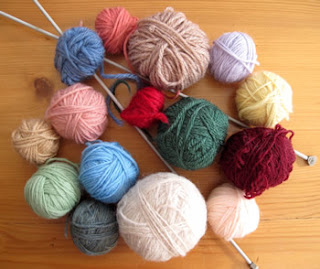Twisted cords are easy and fun to make and have numerous uses. If you aren't sure how to make one please read on.

You can make a twisted cord in any size. Multicoloured and chunky (knitting yarn), very fine (sewing thread), one shade (yarn), smooth and bright (embroidery floss), glitzy and festive (sparkly yarn).

You need to start by choosing the yarn or thread that is right for your project. If you want a thick cord then you'll need to twist several lengths together. I'm using just 2 shades of yarn for this demonstration (one length of each). The yarn must be cut a little over 4 times the length that is required. So if you need a 30 cm (12 in) cord you should cut the yarn 120 cm (48 in) long.

Fold the yarn in half to make it 60 cm (24 in) long and place the loop on a key or door handle to hold it firm. At the other end knot the 4 ends of yarn together and push a pencil through the loop.

With your left hand pull the yarn to keep it tight and with the other hand start winding the pencil in a clockwise direction. You'll quickly will see the yarn starting to twist.

There are no rules about how many twists are needed but you will quickly start to recognise the right amount once you have made a few cords.

Once you feel you've done enough twists with the pencil remove the yarn from the key with your left hand and hold it firmly. Make sure you keep the tension in the cord.

If you accidentally release the yarn it will twist on its own and this is the jumbled effect you will get. If this happens you can keep hold of the pencil end with your right hand and gently untangle the jumble with your left.

Keeping the tension in the cord move your left hand along the cord towards the pencil, releasing it a short length at a time. It will automatically begin to twist.

When the cord has stopped twisting remove the pencil and tie a knot in the open end of the cord to prevent it unwinding.

And here it is...one brightly coloured cord ready for use.











 With your left hand pull the yarn to keep it tight and with the other hand start winding the pencil in a clockwise direction. You'll quickly will see the yarn starting to twist.
With your left hand pull the yarn to keep it tight and with the other hand start winding the pencil in a clockwise direction. You'll quickly will see the yarn starting to twist.


 Keeping the tension in the cord move your left hand along the cord towards the pencil, releasing it a short length at a time. It will automatically begin to twist.
Keeping the tension in the cord move your left hand along the cord towards the pencil, releasing it a short length at a time. It will automatically begin to twist.









